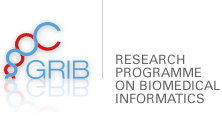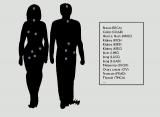
10/04/2018
Major milestone reached in effort to identify cancers’ genetic roots
The project Cancer Genome Atlas details genetic mutations driving cancer in 27 papers published on 5 April in Cell Press journals. One of the studies is led by Washington University and has the participation of the head of the Computational RNA Biology group of GRIB, Eduardo Eyras.
An international team coordinated by the National Institutes of Health (NIH) have reached a major milestone in describing the genetic landscape of cancer. The researchers have completed the genetic sequencing and analyses of more than 11,000 tumours from patients, spanning 33 types of cancer. These are part of The Cancer Genome Atlas (TCGA) project, launched in 2005 to pursue the genetic basis of cancer.
Altogether, the researchers have identified about 300 genes that drive tumour growth. And, remarkably, just over half of all tumours analysed carry genetic mutations that could be targeted by therapies already approved for use in patients. The results appeared on 5 April in 27 papers published in Cell Press journals.
The researcher Li Ding at Washington University led a study group within the project and Eduardo Eyras, ICREA research professor at UPF, has participated in one of these studies published in Cell Reports. "For the tumours we analysed, we now know in detail the inherited mutations driving cancer and the genetic errors that accumulate as people age, increasing the risk of cancer", said Li Ding. "This is the first definitive summary of the genetics behind 33 major types of cancer".
Genomic studies over the past decade have demonstrated that cancer is a disease of errors in genes rather than particular organs. "We can now use molecular features to identify the cancer's cell of origin", Ding said. "We are looking at what genes are triggered in the tumour, and that brings us to a particular cell type. For example, squamous cell cancers can arise in the lung, bladder, cervix, and some tumours of the head and neck. We have traditionally treated cancers in these areas as completely different diseases. But by studying their molecular features, we now know such cancers are closely related".
Eduardo Eyras has participated in the study of the splicing alterations in tumours. "These analyses reveal that a significant number of mutations studied previously were poorly classified, and it could be more relevant than was thought to understand cancer and for the identification of therapeutic strategies", describes Eyras.
The research supports the idea that tumours of any type with high numbers of mutations -which are often resistant to chemotherapy- are susceptible to immunotherapy drugs called checkpoint inhibitors. Highly mutated tumours produce comparatively more misshapen proteins that can trigger an immune response. But as a safeguard against autoimmunity, the body often puts the brakes on, such an immune response. Still, to treat aggressive tumours, checkpoint inhibitors can remove those brakes, letting the immune system fight the tumour more effectively.
The prospect of using these analyses to re-examine data from past clinical trials is very interesting. Many times, a small proportion of patients in a given trial did well under an experimental therapy, but many others did not respond to the treatment at all, and researchers did not understand why.
"Now, we can sequence the tumour samples from patients enrolled in past trials with our latest software tools. We can look for correlations between the patients' genomics and how they responded to the treatments. If we do this for many past trials, we will have tremendous statistical power to identify reasons why drugs work for some patients and not others. So even negative trials that might have been a disappointment at the time can become powerful tools to design better treatments in the future".
"These analyses are only the beginning of a new era in the genomics of cancer. With the tools developed and based on these results, we are now expanding our analysis to new tumours to establish a more complete map of the therapeutic vulnerabilities of each patient according to the molecular characteristics of the tumour", Eyras concludes.
TCGA is a collaborative effort involving more than 20 institutions and is funded by the National Cancer Institute and National Human Genome Research Institute, both of the National Institutes of Health (NIH).
Text adapted from the press release from Washington University Major milestone reached in effort to ID cancers' genetic roots
By following this link you can see all the papers' references.
Eyras article ref.: Jayasinghe RG, Cao S, Gao O, Wendl MC, Vo NS, Reynolds SM, Zhao Y, Climente-González H, Chai S, Wang F, Varghese R, Huang M, Liang WW, Wyczalkowski MA, Sengupta S, Li Z, Payne SH, Fenyö D, Miner JH, Walter MJ. The Cancer Genome Atlas Research Network, Vincent B, Eyras E, Chen K, Shmulevich I, Chen F, Ding L. Systematic Analysis of Splice-Site-Creating Mutations in Cancer. Cell Rep, 2018; 23(1): 270-281.e3. DOI: 10.1016/j.celrep.2018.03.052.



